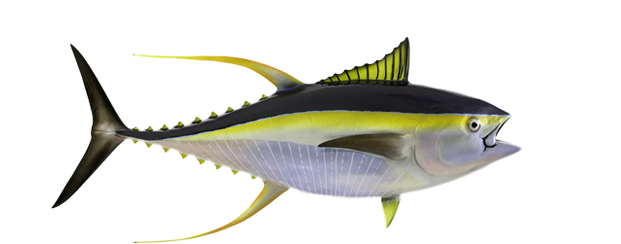Yellowfin, Tuna

View Regulations

Scientific Name
Thunnus albacares


Common Names
Allison, Ahi, Allison tuna, Albacore, Autumn albacore, Yellow-finned albacore


Description
The yellowfin tuna gathers it’s name from it’s yellow tipped dorsal and anal fins and these same fins can grow to resemble a sickle like shape. The body itself is shaped like an elongated football. The yellowfin’s coloration begins as blue-black on it’s back blending to silver on the lower body, punctuated by a yellow or blue stripe along the body. Besides the yellow fin’s there are black marks on the fins that help distinguished it from other tuna’s


Habitat & Behaviour
Yellowfin tuna are commonly found across the globe in deep, warm and temperate waters. While larger adult fish travel in deeper waters and in smaller numbers, younger juvenile yellowfin gather in larger schools closer to the surface. Though they are a migratory fish and dwell in middle depths they occasionally can be found in warmer currents reasonably close to shore.


Natural Prey
Yellowfin Tuna primarily consume prey in open ocean waters on fishes and invertebrates found with giant kelp. They can eat shrimp ,larval crabs, filefish, triggerfish squids, and jacks.


Handling Tips
Grab by tail when get close to boat, tail snares can be useful if the fish is larger. Can be very strong and gill plates can be very sharp. They have rows of teeth so do not put your finger in its mouth (teeth not especially sharp but still wouldn't be good to get bitten!). Gaff larger ones in back of head if harvesting. Ice right away, make cut in tail to bleed them. Warm blooded fish – melt ice quick so you need to bleed them. Flesh is desirable – so keep water and ice away from the flesh. See the How to Fillet a Tuna video for more details in the Essentials section of the app.

- Lucky Tackle Box
- Billfish Bounty in the Heart of the Mayan World – Guatemala
- The Best Species of Shark to Catch
- How to Catch a Shark: what equipment do you need?
- The Best Winter Fishing Spots in Texas






